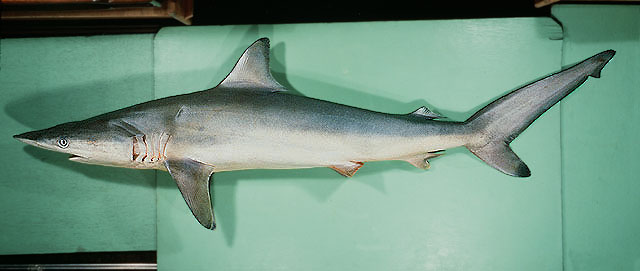| Carcharhinidae (Requiem sharks) |
| 309 cm TL (male/unsexed); max.weight: 193 kg; max. reported age: 16 years |
|
reef-associated; marine; depth range 0 - 100 m, oceanodromous |
| Atlantic, Mediterranean and Indo-West Pacific, warm temperate and tropical (Ref. 58085). Often referred to as Carcharhinus limbatus in the past. |
|
Dorsal spines (total): 0-0; Dorsal soft rays (total): 0-0; Anal spines: 0-0; Anal soft rays: 0-0. A slender shark with a long, narrow, pointed snout, long gill slits and small, narrow-cusped teeth; first dorsal fin small; no interdorsal ridge; labial furrows longer than in any other grey shark (Ref. 5578). Grey above, white below, with a conspicuous white band on sides; second dorsal, anal, undersides of pectorals and lower caudal-fin lobe black or dark grey-tipped in subadults and adults, but unmarked or nearly so in small individuals (Ref. 9997). |
| Found on the continental and insular shelves from close inshore to offshore (Ref. 244). Makes vertical spinning leaps out of the water as a feeding technique in which the sharks spins through a school of small fish with an open mouth and then breaks the surface (Ref. 9997). Feeds mainly on pelagic bony fishes, also small sharks, cuttlefish, squids, and octopi (Ref. 244, 5578). Viviparous (Ref. 50449). Forms schools (Ref. 244). Highly migratory off Florida and Louisiana and in the Gulf of Mexico (Ref. 244). Regularly caught in fisheries where found (Ref. 244). Utilized fresh and dried salted for human consumption (Ref. 244). Fins probably used in the oriental shark fin trade, and livers for vitamin oil production (Ref. 9997). |
|
Vulnerable (VU); Date assessed: 11 February 2020 (A2bd) Ref. (130435)
|
| harmless |
Source and more info: www.fishbase.org. For personal, classroom, and other internal use only. Not for publication.
